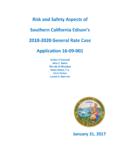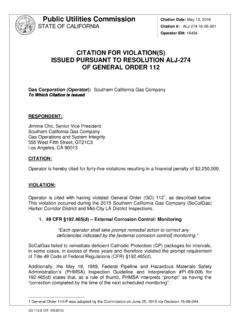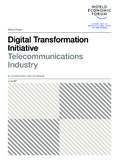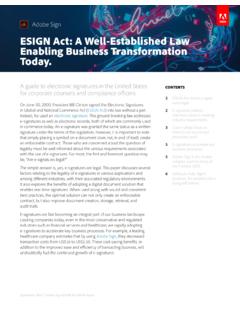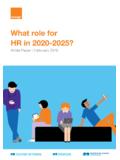Transcription of Draft Green Book May 2018 i - cpuc.ca.gov
1 Draft Green Book May 2018 i Principal Authors Michael Colvin, Policy & Planning Division Diane I. Fellman, Policy & Planning Division Raisa Ledesma Rodriguez, Executive Division Contributing Author Alison LaBonte, Energy Division Principal Editor Rohimah Moly, Office of President Michael Picker Disclaimer This Draft paper was prepared by California Public Utilities Commission (CPUC) staff. It does not necessarily represent the views of the CPUC, its Commissioners, or the State of California. The CPUC, the State of California, its employees, contractors, and subcontractors make no warrants expressed or implied and assume no legal liability for the information in this paper. This paper will not be approved or disapproved by the CPUC, nor has the CPUC passed upon the accuracy or adequacy of the information in this paper.
2 More information on the California Customer Choice Project and a digital copy of this paper can be found at: Draft Green Book May 2018 ii In the late 1990s, California deregulated the electric industry, allowing customers to choose their power supplier. But in 2000 and 2001, the new electric system collapsed, saddling customers with high costs and rolling outages. The California Legislature reset the large regulated utilities as the dominant providers of electric service, although the utilities no longer owned most power generators. Customers are once again departing from the utilities as providers of their electricity. They are getting power from rooftop solar panels, from local agencies called Community Choice Aggregators or from private electric re-sellers called Direct Access providers.
3 Large industrial customers are buying power directly from renewable generators, sometimes serving several locations from a distant wind farm or solar plant. Fewer and fewer customers are getting power from the traditional large regional utilities and the central decision making that we use for keeping the grid reliable, safe and affordable is splintering, becoming the task of dozens of decision-makers. In the last deregulation, we had a plan, however flawed. Now, we are deregulating electric markets through dozens of different decisions and legislative actions, but we do not have a plan. If we are not careful, we can drift into another crisis. This paper is produced by the California Public Utilities Commission's Policy and Planning Division.
4 While much of our work here is focused on current activities and implementing various laws, the Policy and Planning Division looks forward and conducts policy research on new and emerging trends. It researched the experience of other states and governments to see what has worked to give customers more control over how they get their electricity, and to evaluate what might be best for California. The paper asks us to consider such question as: How do we protect safe delivery of electricity to meet customer demand in an increasingly fragmented market? How will we ensure that increasing fragmentation of suppliers and buyers will add up to meet our ambitious clean energy goals? How will we make sure that different players are meeting their responsibilities to provide all the energy resources we need to make the grid work?
5 How will we protect customers from the unfair behavior like slamming and cramming that we saw during deregulation of telecommunications? What preparations should we make for customers who might become stranded without service if their electric provider fails, as many did in the previous California deregulation? What is the best way for a fair, affordable and durable transition? Some of these decisions will require leadership from the Legislature, although others must be solved by the California Public Utilities Commission, with the help of our partners at the California Energy Commission and the California Independent System Operator. We plan to follow the publication of this white paper with a public workshop to hear comments and responses from the players who are driving this transformation of our electricity supply.
6 And then we will dig deeper into solving the questions that the issues raised in this white paper demand that we answer. Sincerely, Michael Picker, President California Public Utilities Commission Draft Green Book May 2018 iii Abstract External changes driven by an uptake of distributed energy resources, the growth of non-utility load serving entities, and policy measures taken to mitigate climate change have provided customers more options to choose how and from whom they obtain electric services. While these changes create greater choices for customers, they also pose regulatory challenges. Following a May 19, 2017 en banc hearing with the California Energy Commission on customer choice, the CPUC.
7 Formed the California Customer Choice Project. Its mission is to aid the CPUC in making strategic, timely and informed decisions regarding California's current electricity market transformation. Specifically, the California Customer Choice Project has been charged with analyzing a fundamental question: How does the increased customer choice occurring in the electric sector impact California's ability to achieve its policy objectives of affordability, decarbonization, and reliability? Recognizing that these policy objectives are interwoven with one another and that there is no simple answer or obvious path, the Project approached the question by: 1. Reviewing California's history with customer choice.
8 2. Identifying California's energy policy goals through Core Principles and Key Questions;. 3. Defining customer choice;. 4. Evaluating representative national and global regulatory models that enable high penetration of customer choice: New York, Illinois, Texas and Great Britain; and 5. Leveraging lessons learned from California's history and other markets to make observations and findings on what is necessary to achieve the state's energy policy goals. This Draft paper sets the stage for a conversation among California energy policy decision-makers and stakeholders about the need to develop a plan to address the current shift in the evolving electricity market and the next steps in managing this transition.
9 The paper provides a holistic and strategically agnostic view of the interdependent attributes related to customer choice. Part I is an Introduction containing the problem statement and an overview of the key issues. Part II discusses the current status of California. Part III presents the Core Principles of affordability, decarbonization and reliability along with the Key Questions for considering customer choice. This section defines what is choice and what it is not. Part IV evaluates New York, Illinois, Texas and Great Britain's regulatory frameworks and identifies findings for further consideration. Part V draws from the analysis of California's history and other markets to make observations and identify considerations for California decision-makers.
10 The appendices following the paper provide more detailed background information and analysis. Notably, Appendix I provides a detailed history of competition and customer choice in California. The state was the first electricity market in the nation to consider full retail choice as well as the first to abandon the effort. California's flawed plan offered lessons for other jurisdictions contemplating retail competition and market-based approaches to deliver energy services. Today, this history and these other markets provide insights based on two decades of experience to inform the assessment of California's current electricity market and to develop a pathway forward. The paper presents findings from the different electricity markets to draw upon when deliberating policy and regulatory changes.




